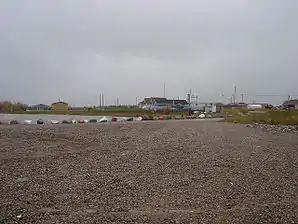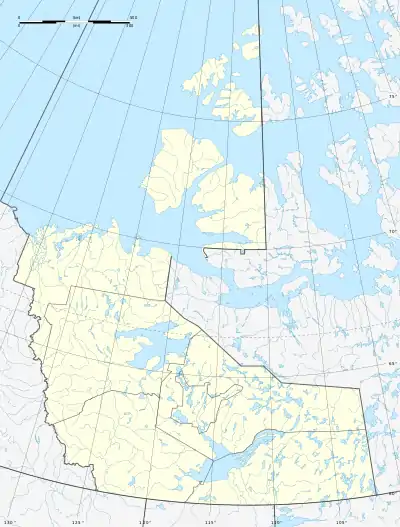Fort Resolution
Fort Resolution (Deninoo Kue „moose island“) ist eine „settlement corporation“[2] in der South Slave Region in den Nordwest-Territorien, in Kanada. Die Gemeinde liegt an der Mündung des Slave River in den Großen Sklavensee und am Ende des Fort Resolution Highways (Highway 6). Sie ist der älteste dokumentierte Ort in den Nordwest-Territorien. Fort Resolution hatte eine Schlüsselstellung auf der nördlichen Wasser-Pelzhandelsroute. Der Ort ist als ein nationales Kulturerbe anerkannt.
| Fort Resolution | |||
|---|---|---|---|
| Lage in Kanada | |||
| |||
| Staat: | |||
| Territorium: | Nordwest-Territorien | ||
| Region: | South Slave Region | ||
| Koordinaten: | 61° 10′ N, 113° 40′ W | ||
| Einwohner: | 470 (Stand: 2016[1]) | ||
 Ortsansicht | |||
Die Bevölkerungszahl betrug laut kanadischem Zensus von 2006 484 Einwohner. Die Mehrheit der Einwohner sind Dene oder Métis. Die vorherrschenden Sprachen sind Englisch, Chipewyan und Michif.
Die Stadt besitzt ein Eishockeystadion, eine Bürgerhalle, ein Altenheim, eine RCMP-Station und zwei Tankstellen. Ein kleiner Flugplatz, Fort Resolution Airport, bietet Charterflüge und dient für medevac-Flüge. Das älteste Gebäude der Stadt ist die katholische Kirche, die im frühen 19. Jahrhundert gebaut wurde. Der Strand des Great Slave Lake ist der Hauptplatz für Schwimmen, Vogelbeobachtung und Erholung. Die Einwohner fischen und jagen Karibus, Schneehühner und Kaninchen das ganze Jahr über.
Das nahe gelegene Pine Point war einst eine Bleimine. Als der Wert von Blei in den 1980er Jahren sank, wurde die Mine geschlossen und der Ort aufgegeben. Viele der Häuser wurden für $1 verkauft und in Fort Resolution oder Hay River wieder aufgebaut.
„Deninu Days“ in Spätaugust ist eine Feier anlässlich der beginnenden Karibujagdsaison mit Paraden, Spielen und Talentwettbewerben. Eine Erholungsmöglichkeit ist der nahe „Little Buffalo River Crossing“, ein Territorial Park, mit historischen und Naturattraktionen.
Fort Resolution wird durch die Deninu Kue First Nation repräsentiert und ist Teil des Akaitcho Territory Government.[3]
Referenzen
- Statistics Canada: Population and dwelling counts, for Northwest Territories and census subdivisions (municipalities), 2016 and 2011 censuses, abgerufen am 4. Mai 2021
- Differences in Community Government Structure (PDF; 59 kB)
- Indian and Northern Affairs Canada. (Memento vom 11. Juni 2007 im Webarchiv archive.today)
Literatur
- P. Deprez, A. Bisson: Demographic differences between Indians and Métis in Fort Resolution. Center for Settlement Studies, University of Manitoba, Winnipeg 1975.
- L. C. Driedger: Kinship, marriage and residence in Fort Resolution, N.W.T. National Library of Canada, Ottawa 1990, ISBN 0-315-55603-X.
- G. Fields, G. Sigurdson: Northern co-operatives as a strategy for community change; the case of Fort Resolution. University of Manitoba, Center for Settlement Studies, Winnipeg 1972.
- Fort Resolution Education Society: That's the way we lived an oral history of the Fort Resolution elders. Fort Resolution Education Society, Fort Resolution, N.W.T. 1987.
- C. J.-H. Kim: Assessment of cadmium intake from the consumption of traditional food in Fort Resolution, Northwest Territories. National Library of Canada = Bibliothèque nationale du Canada, Ottawa 1996, ISBN 0-612-12213-1.
- C. Lafontaine: Concentrations of metals and trace elements in muscle and liver of fish collected from Great Slave Lake, Fort Resolution area, NWT final report. The Division, Yellowknife 1997.
- M. Mercredi: An outline for a traditional skills camp proposed by the Fort Resolution Settlement Council. Govt. of the Northwest Territories, Yellowknife? 1988.
- D. M. Smith: Moose-Deer island house people a history of the native people of Fort Resolution. National Museums of Canada, Ottawa 1982.
- D. M. Smith: INKONZE: magico-religious beliefs of contract-traditional Chipewan trading at Fort Resolution, NWT, Canada. Mercury series. National Museum of Man, National Museums of Canada, Ottawa 1973.
- J. C. Van Kessel: Taking care of bison community perceptions of the Hook Lake Wood Bison Recovery Project in Fort Resolution, N.T., Canada. National Library of Canada = Bibliothèque nationale du Canada, Ottawa 2004, ISBN 0-612-81493-9.
